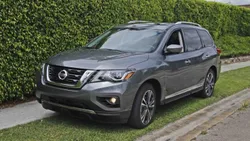

Nissan Pathfinder Generation 4 Overview
Explore the Nissan Pathfinder Generation 4 and its features. Discover how this model stands out in Portugal's automotive market, especially for SUV enthusiasts.
The Nissan Pathfinder, a staple in the SUV segment, underwent its fourth generation from 2005 to 2012. This generation was a significant culmination of the Pathfinder's evolution, blending rugged off-road capabili...
History and Features
Mycarro AI
Apr 27, 2025
The Nissan Pathfinder, a staple in the SUV segment, underwent its fourth generation from 2005 to 2012. This generation was a significant culmination of the Pathfinder's evolution, blending rugged off-road capabilities with the comforts expected in a family vehicle. It marked the transition from a body-on-frame structure to a crossover, paving the way for subsequent models.
Design and Dimensions
The fourth-generation Nissan Pathfinder saw a complete transformation in design philosophy. This model adopted a unibody construction, which significantly lightened its weight and improved ride quality. The exterior featured a more aerodynamic profile, with rounded edges and a more modern front fascia, which helped distinguish it from its rugged predecessors. With a length of approximately 193.3 inches and a width of 74 inches, the Pathfinder offered ample interior space while retaining a manageable size for urban driving.
Inside, the Pathfinder was designed to prioritize passenger comfort and cargo versatility. With three rows of seating that could accommodate up to seven occupants, it provided generous headroom and legroom in all rows. The interior was further complemented by high-quality materials, improved sound insulation, and various trims, making this generation appealing to families and adventure enthusiasts alike.
Performance and Engine Options
Under the hood, the fourth-generation Pathfinder initially came equipped with a 4.0-liter V6 engine that produced around 270 horsepower and 291 lb-ft of torque. This powerplant was mated to a five-speed automatic transmission, which provided a smooth driving experience. The vehicle's performance was marked by competent acceleration and sufficient towing capacity, enabling it to haul trailers up to 6,000 pounds when properly equipped.
In 2010, a 5.6-liter V8 engine was introduced for the welcoming of the new model year. This powertrain option elevated the Pathfinder's capabilities, especially for buyers looking for enhanced performance and towing capacity. The addition of All-Mode 4WD ensured that the SUV maintained excellent traction on various terrains, making it apt for both off-road adventures and on-road driving.
Technology and Features
Throughout its production, the fourth-generation Pathfinder saw a constant evolution of technology and features. Various trims offered advanced options such as navigation systems, Bluetooth connectivity, and an optional rear entertainment system. Higher trims included features like a sunroof, premium audio systems, and heated leather seats, which greatly enhanced the driving experience.
Safety features were also a priority in this generation, with the Pathfinder equipped with multiple airbags, antilock brakes, stability control, and various advanced options depending on the trim level. It received satisfactory safety ratings, making it a reliable choice for family-oriented consumers.
Driving Dynamics
The driving dynamics of the fourth-generation Pathfinder represented a notable step forward from its predecessors. The unibody design contributed to a more car-like ride, with smoother handling in both urban and highway conditions. The suspension was tuned for comfort while still providing enough response during spirited drives or light off-roading.
Some owners appreciated the balance this SUV maintained between ruggedness and comfort. However, enthusiasts noted that it lacked the off-road nimbleness of the previous body-on-frame models. Despite this, it was still capable of tackling dirt roads and moderate trails, making it versatile for any adventure.
Market Position and Legacy
The Nissan Pathfinder Generation 4 was positioned as a family-friendly SUV in a market increasingly leaning towards crossovers. Its spacious interior, decent fuel economy, and comfortable ride made it a strong contender against competitors like the Honda Pilot and Toyota Highlander. This generation helped Nissan solidify its presence in the midsize SUV segment and laid the foundation for future model iterations.
As the fourth generation came to a close in 2012, the Pathfinder nameplate would soon transform once more into a more crossover-focused vehicle. This shift signaled changing trends in consumer preferences, but the legacy of the fourth-generation Pathfinder remains a favorite among enthusiasts for its combination of rugged capability and family-friendly features.
